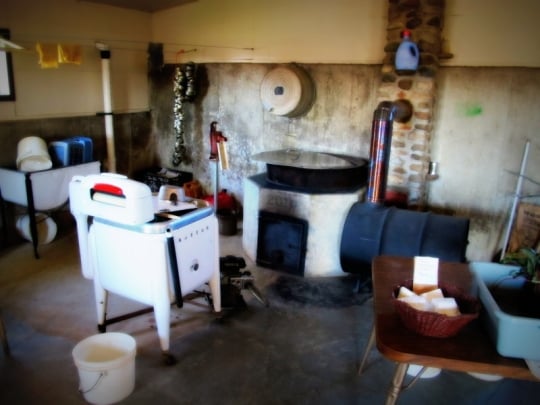Inside an Amish Home: Heat & Wash

A photo taken by reader Rose in the Kingston/Dalton Wisconsin Amish community. What do you notice?


A photo taken by reader Rose in the Kingston/Dalton Wisconsin Amish community. What do you notice?

Similar Posts
‘No motive for the deed is known, as he was wealthy and popular.’ Reporting of long ago can seem…a bit, well, simplistic, can’t it? As in, what was the reporter’s thought process? Wealth? Check. Popularity? Check. So what was this Shrock fellow’s problem? What else could there have been to life? This is from a 1903 New York Times article. Shrock, whatever his troubles may…
With close neighbors Ohio and Pennsylvania home to over 130,000 Amish, you’d think a few people with an itch to move would have looked south or east and considered the Mountain State. There are some Amish spots on the WV map, but not many–three to be exact. West Virginia is just not as attractive to Amish for whatever reason, especially compared to places like New York or…
Ernest Bontrager has a clip of still images taken in the Amish settlement at Monte Vista, Colorado (Rio Grande and Conejos counties). It’s not a new video (2010), but is a nice look at the type of sights you might see in a western Amish settlement. I haven’t visited Amish further west than Iowa, so I like these looks at communities in the Mountain Time Zone….

Like my visit to Enon Valley, PA in December, I only had a brief time at the Amish community at Halifax County, VA. I was returning home from my multi-state Amish trip after 2000+ miles traveled. And as you’ll see from these photos, it was the end of the day. Still, it was worth the journey, mainly for one family I met while there. The Amish of Halifax…
Hi everyone, and thanks for all the feedback on the semi-controversial book video. I meant to post something from here in Lancaster County much sooner, but funny thing, every Amish home I visit claims their Wi-Fi connection is down. Frustrating. As I’m on some dodgy illicit kerosene-powered land line tucked away in a tobacco barn right now, and I don’t know how much longer it…
Which states have the most Amish settlements? I should first note that this post is about individual settlements, not total Amish population. The two have some correlation, but are not the same thing. An Amish settlement is a distinct geographic location where Amish live. The roughly 350,000-strong Amish population is found in close to 600 separate settlements – most in the US, with around 20…
22 Comments
Is that a wringer dryer? You put the clothes in, turn a hand crank and it squeezes water out? Later you put the clothes out on the line to dry. No electricity. I think my mom had one when I was little but then we got better off and got a “real” dryer…
Is that a small motor on the ground to power the wringer washer?
I am so proud that I am so humble.
heat source?
Ruth uses the same kind of machine for washing. I’m wondering about the vertical pole just the other side of this. Looks like possibly a pump for water? And what’s that large thing behind all of this, maybe a heat source? Seems to have a chimney flue and maybe some kind of heating compartment? These are wild guesses!
I believe the large thing behind is a kettle stove. My Swartzentruber Amish friends in Randolph, MS have one. I was told it heats the water for doing the washing. They power their wringer washer with a gasoline motor, and of course hang their clothes on the line. The wringer washer is not hard to use, I have one and love it in the summer. Really helps to keep my power bill low, and nothing smells better than fresh wash off the line!
I am so thankful for my washer & drier.. I’d love to hang my clothes outside & used to when I lived in the country but it’d sure be a pain on some of these snowy winter days.
hanging out wash
My local Amish neighbors hang out (on the regular clothes lines)on any sunny dry but cold days. But if its raining/sleeting/snowing, or just too cold, they string up ropes in the house (and/or on the covered porch for smaller “loads”)- the hooks are always there in place, so all they have to do is string the ropes onto them and up go the laundry. Sara
wash day
Sometime I think us people in the world has it to easy. People in the world, is thanful what we have. I love JESUS !
Memories
Boy, seeing that picture brought back memories from when I was growing up. We used an old wringer washer like that until I was in Jr. High School, the only reason we upgraded to an automatic washer was because we couldn’t get parts for the wringer machine anymore & we didn’t have a dryer until after I was grown & gone.
I wish I had one of those old wringer machines now. Loved them. I do hang my clothes out on the clotheslines though
Blue barrel appears to be part of a heating source. PVC pipe in wall looks to be a drain, but for what purpose? I don’t see a floor drain for the washer, but do see buckets around. Do they have to haul the used water by bucket? Or is the sump pump just out of sight—PVC pipe is rising from it–my guess (like at my house).
It looks like something green growing in the blue plastic tub on the table. What is it? (It also reminds me that I’ll need to start some vegetable seeds in a couple of weeks!)
Alice Mary
Rose writes me that this is actually the same room as the mud room photo of a couple weeks ago: https://amishamerica.com/inside-an-amish-home-muddy-pairs/
Somewhat off topic, but clothes dry just fine inside in the winter. We have a drying rack that I put a wash on in the evening before I go to bed and the load is almost always ready for folding in the morning before work. I set it up in front of the masonry heater in the living room and the gentle heat and dry winter air do the rest. Overnight drying also keeps the laundry out of the way during the day. During other times of year clothes dry better outside (during the day) so that’s where they go then. We have a dryer, but it goes weeks without use.
Check out this book.
http://www.amazon.com/Amish-Christian-Addiction-Conviction-Faith-Power-Adam-Fischer/dp/1449759467/ref=sr_1_1?ie=UTF8&qid=1361511366&sr=8-1&keywords=amish+to+christian
A field stone chimney. That must have been fun to build. I wonder what is in the bottle setting on that shelf on the chimney? What needs warming like that?
In the far corner hangs a string with a LOT of canning lid rings on it.
I wonder if the pitcher pump is well water or cistern rain water. Rain water is a lot softer and make much better clothes and people washing water.
What jumped out at me was the bottle of fabric softener by the chimney 🙂
Seeing that wringer washer makes me nostalgic, but it also reminds me how much better-made the old products were. My husband is parts mgr. at an appliance store; he says the new washers are constantly breaking down, some when they’re only a few months old. They are very expensive appliances but they’re really junk.
Barbara, I too noticed a fabric softener bottle on the shelf by the chimney. Softener can thicken if it gets too cold (thanks, Lance for the warming idea). The washer lid is propped open to dry, a rinse tub (on caster wheels?) holds a laundry basket and buckets, a galvanized washtub or “vesh tsuvvah” is hanging on the wall (useful for pre-soaking), and I see a wood-fired water heater (was it built in 2011?). A fire can be built under the big black kettle (cast iron?) that is filled with water. I don’t know what the purpose is of the 55-gallon drum on its side.
Where’s the soap? In the basket?
The large item at the back looks very much like the “copper” my grandma in Australia used to wash her clothes in until the 1970’s. It was located in the wash house in the back yard and on Monday wash day grandpa would fill it with water and light a fire in the box underneath. When the water was hot the clothes went in to be boiled. She had concrete laundry troughs along side and one of these was filled with rinse water. The laundry was pulled from the copper with a stick, rinsed then put through a wringer (like on the washing machine) that was hand cranked. The wringer sat between the twin concrete troughs.
The wash then went outside to dry or into the back porch if the weather was wet.
When grandma was in her 70’s she and grandpa installed plumbing into the back porch and bought a washing machine and put in an inside toilet there too. Thanks for the opportunity to reminisce about this.
To me the 55 gallon drum looks like it may be a home made wood or coal stove when more heat is needed on cold Wisconsin days.
Ban hammer time
Morons will be morons. Drop the hammer on ’em Erik.
Spam mail
Okay I know this is entirely off topic and I do apologize.
This morning I received spam mail regarding Amish furniture. I recognize the address for unsubscribing. It’s spam mail. Please if you get one of those just delete it. Don’t respond! Spammers love to get return mail asking to unsub–it tells them the account is live!
Just thought I’d mention it in case others get this type of mail…
I now return you…
Margaret, no need to apologize and thank you for mentioning this
Wringer washing machine
It’s at the Bontrager farm that has 5 acres with produce they sell for income. It’s a stop on my tours there for the past 20 years. Their newly married daughter and husband live in a building on the farm.
Richard